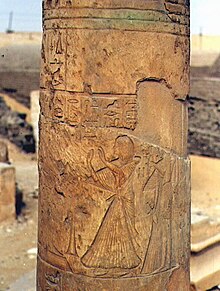
Tia was an ancient Egyptian high official under king Ramses II. His main title was that of an overseer of the treasuries. [1] Tia was married to a woman with the same name, the princess Tia who was sister of Ramses II.

Tia was an ancient Egyptian high official under king Ramses II. His main title was that of an overseer of the treasuries. [1] Tia was married to a woman with the same name, the princess Tia who was sister of Ramses II.
Not much is known about the early years. One of the earliest mentions of Tia is on a block now in the University of Chicago Oriental Institute (no. 10507). Tia and a man named Amenwashu are shown before King Seti I and the then crown-prince Ramesses II. Habachi conjectured that Amenwashu was Tia's father, but there is no evidence to support this idea. The identification of the man Tia on the Chicago stela with the official Tia is based on the rarity of the name. It is not known when Tia married Ramesses's sister Tia. [2]
Tia had several honorific titles including hereditary prince and governor, seal-bearer of the King, sole companion, overseer of the secrets of the royal palace, favorite of the Horus in his palace, eyes of the King, and ears of the King. Tia's executive titles include, King's scribe, fanbearer on the right of the King and his most common title: overseer of the treasury in the Temple of Usermaatre Setepenre in the Domain of Amun. [2]
A limestone block shows Tia and Tia in the presence of Queen Tuya. This scene likely comes from the tomb in Saqqara is now in the Royal Ontario Museum (no. 955-79-2). Tuya is said to be a God's Wife and a King's Mother. [3] Tia is clearly stated to be the King's sister and this scene shows that she was indeed the sister of Ramesses II.

Tia and Tia are best known from their tomb at Saqqara [2] which was placed between the tomb of the 18th Dynasty general Horemhab (the later king) and the overseer of the treasuries Maya, the latter had the same title as Tia. The tomb is not very well preserved. The main entrance was on the east side. There was a first courtyard and a second one that was adorned with columns. At the back there were chapels and at the very back a small pyramid. [4]
The outer courtyard of the tomb contained two smaller tomb-chapels. One of the chapels belonged to Iurudef, while the name of the owner of the second chapel is not known. A stela of an official belonging to the household of Tia, named Panakhtenniut, was found nearby. There is, however, no evidence that he was the owner of the chapel. [2]
Tia was already known from several objects before his tomb was discovered. A pyramidion reached England in 1722 and was brought there from Alexandria. It is only known from old drawings, but they are good enough to read the name and titles. [5]
Tia was once buried in a set of three coffins. There was a wooden inner, anthropoid coffin, a middle granite, anthropoid coffin and an outer, wooden, rectangular coffin. The coffins were only found in small fragments. [6]
Not all materials mentioning Tia and Tia come from the tomb in Saqqara. Ahmed Mahmoud Moussa discovered a funerary chapel at Kafr el-Gebel which is located to the south of the Giza Pyramid Plateau at the edge of the desert. [2] In Chapel G a stela showing Ramesses II before Osiris and the deified Seti I. A lower register of the stela depicts Queen Tuya followed by Tia and Tia before the goddess Isis and Ahmose (or a statue of the King). [7]
The 1997 excavation report contains a list of known inscriptions associated with Tia and Tia. [2] Below is a small sample of those inscriptions. These inscriptions are also mentioned in Kenneth Kitchen's Ramesside Inscriptions or are otherwise notable: [3]

Gebel el-Silsila or Gebel Silsileh is 65 km (40 mi) north of Aswan in Upper Egypt, where the cliffs on both sides close to the narrowest point along the length of the entire Nile. The location is between Edfu in the north towards Lower Egypt and Kom Ombo in the south towards Upper Egypt. The name Kheny means "The Place of Rowing". It was used as a major quarry site on both sides of the Nile from at least the 18th Dynasty to Greco-Roman times. Silsila is famous for its New Kingdom stelai and cenotaphs.
Prince Khaemweset was the fourth son of Ramesses II and the second son by his queen Isetnofret. His contributions to Egyptian society were remembered for centuries after his death. Khaemweset has been described as "the first Egyptologist" due to his efforts in identifying and restoring historic buildings, tombs and temples.
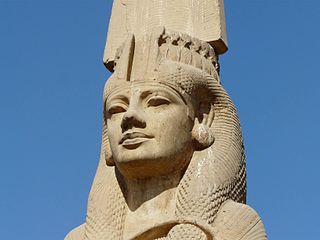
Meritamen was a daughter and later Great Royal Wife of Pharaoh Ramesses the Great.
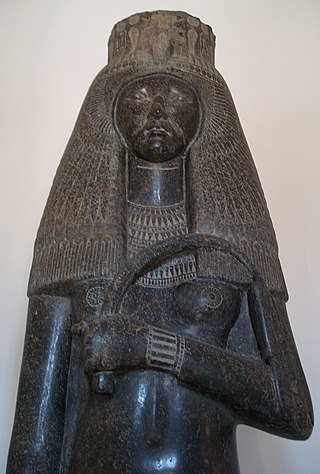
Tuya was the wife of Pharaoh Seti I of the Nineteenth Dynasty of Egypt and mother of Tia, Ramesses II, and perhaps Henutmire.

Henutmire was an ancient Egyptian princess and queen. She was one of the eight Great Royal Wives of Pharaoh Ramesses II of the 19th Dynasty of Egypt.
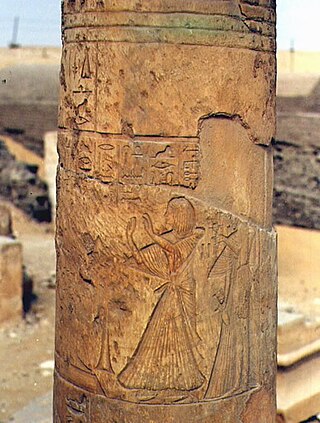
Tia or Tiya was an ancient Egyptian princess during the 19th Dynasty.
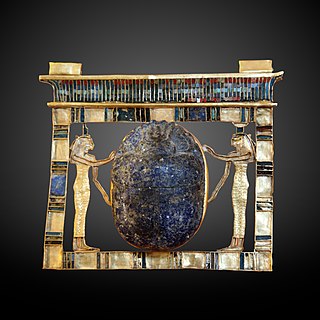
Paser was an ancient Egyptian noble who served as vizier during the reigns of Seti I and Ramesses II in the 19th Dynasty. He would later also become High Priest of Amun.

Setau was the Viceroy of Kush in the second half of Ramesses II's reign. Contemporary records show that Setau served in this position from Year 38 until at least Year 63 of Ramesses II's reign. Setau was "a graduate of the royal school" and already enjoyed an impressive record of royal service which is detailed in a long autobiographical inscription carved at Wadi es-Sebua. The temple of Wadi es-Sebua was built for Ramesses II by Setau around 1236 BC or Year 44 of this pharaoh's reign. Eleven of his stela, now in the Cairo Museum, were found in the courtyard of this temple and make it possible to establish his career and understand the precise duties of a viceroy. Setau states:
I was one whom his Lord caused to instructed....as a ward of the palace. I grew up in the royal abode when I was a youth...I was provided for with bread and beer from all the royal meals. I came forth as a scribe from the school, I was appointed to be Chief Scribe of the Vizier; I assessed the whole land with a scroll. A task I being equal to the task.
Heqanakht was Viceroy of Kush during the reign of Ramesses II. His titles include: King's son of Kush, overseer of the Southern Lands, Fan-bearer on the Right Side of the King, Messenger to every land, Hereditary prince, royal sealbearer.
Paser I was the Viceroy of Kush during the reigns of Ay and likely Horemheb. Reisner mentions that the only datable inscriptions for Paser belong to the reign of Ay. The next known Viceroy however is Amenemopet, who is dated to the reign of Seti I. Hence it's possible that Paser I served during the reigns of Ay, Horemheb.

Pahemnetjer(p3-ḥm-nṯr; "servant of the god", "priest") was a High Priest of Ptah during the reign of Ramesses II. Pahemnetjer succeeded Huy as High Priest of Ptah and was in turn succeeded by his son Didia.

Isetnofret was a royal woman of Ancient Egypt and, as the Great Royal Wife of Pharaoh Merenptah, she became Isetnofret II.
Panehesy was a vizier of ancient Egypt. He served during the reign of Merenptah during the 19th Dynasty.

The Theban Tomb TT214 is located in Deir el-Medina, part of the Theban Necropolis, on the west bank of the Nile, opposite to Luxor.

Khawy was a guardian in the Place of Truth and servitor of Amun of Opet (Luxor) from the reign of Ramesses II. He lived in the workers village Deir el-Medina. Khawy is known from his tomb TT214, his house and several other inscriptions.
This page list topics related to ancient Egypt.

The Department of Egyptian Antiquities of the Louvre is a department of the Louvre that is responsible for artifacts from the Nile civilizations which date from 4,000 BC to the 4th century. The collection, comprising over 50,000 pieces, is among the world's largest, overviews Egyptian life spanning Ancient Egypt, the Middle Kingdom, the New Kingdom, Coptic art, and the Roman, Ptolemaic, and Byzantine periods.
Ptahemwia or Ptah-em-Wia was an Ancient Egyptian official who lived under king Ramses II in the 19th Dynasty, around 1250 BC.
Hori was an ancient Egyptian High Priest of Osiris at Abydos, during the reign of pharaohs Ramesses II.

Tjuneroy was an Ancient Egyptian official under king Ramses II in the 19th Dynasty. His tomb chapel contained the famous Saqqara Tablet.